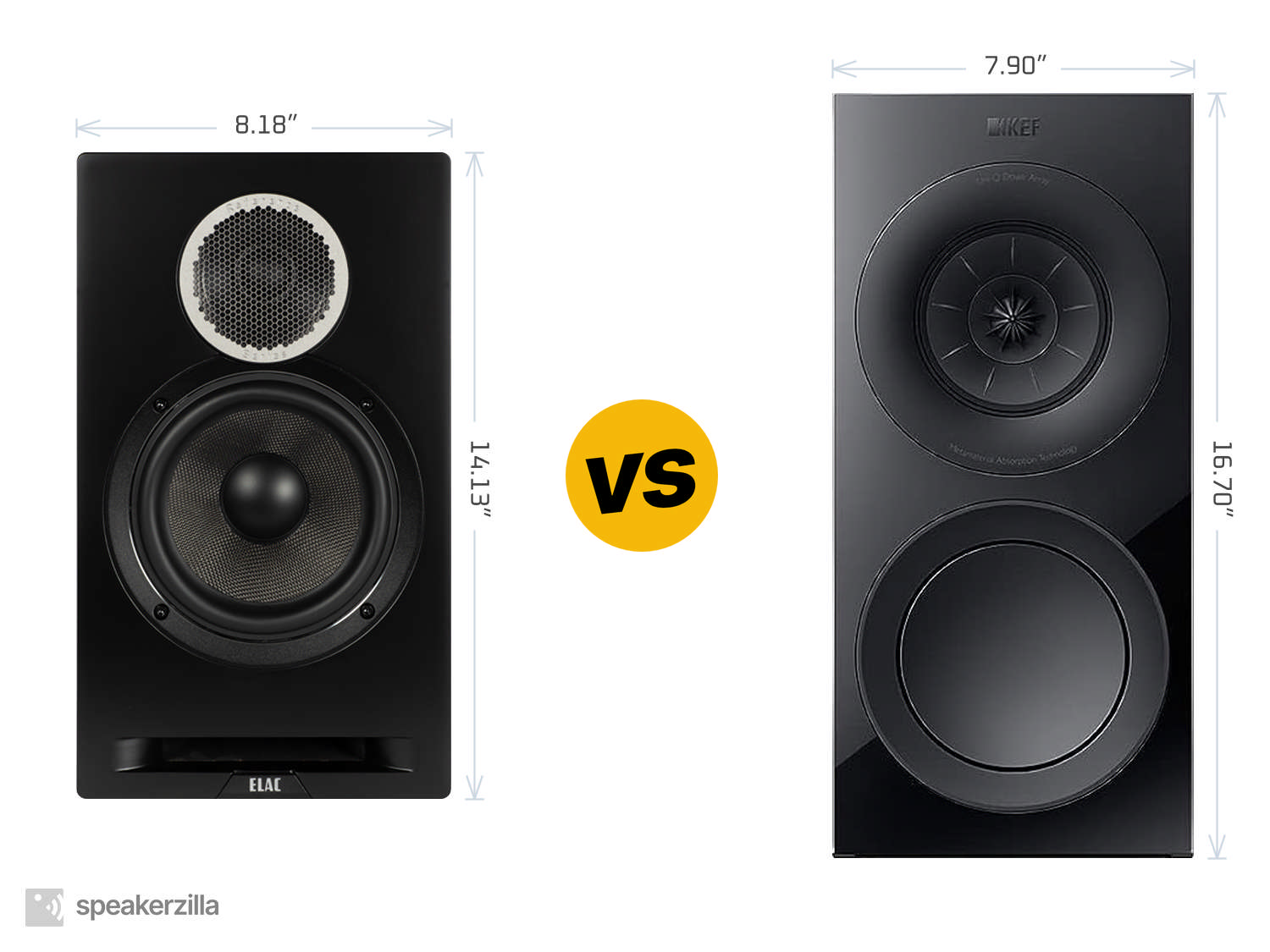ELAC Debut Reference B6.2 vs. KEF R3 Meta

| ELAC Debut Reference B6.2 Bookshelf Speakers | KEF R3 Meta Bookshelf Speakers |
| MSRP | |
| $700 | $2200 |
| Dimensions (H × W × D) | |
|
14.13” × 8.18” × 10.82” 359mm × 208mm × 275mm |
16.70” × 7.90” × 13.50” 424mm × 201mm × 343mm |
| Power Type | |
| Passive | Passive |
| Frequency Response | |
| 44-35,000 Hz | 58-28,000 Hz |
|
Amazon.com
|
Amazon.com
|
Key Takeaways
TLDR Summary: In the world of high-fidelity sound, the ELAC Debut Reference B6.2 speakers offer remarkable value, presenting a warm, engaging sound profile with a clear midrange and extended bass. Meanwhile, the KEF R3 Meta stands as a paragon of transparency and detail, featuring their Uni-Q driver array for a more precise soundstage. Where the ELACs charm with their full-bodied performance at an accessible price, the KEF R3 Meta bookshelf speakers ascend into the audiophile realm with nuanced audio reproduction and exceptional build quality, commanding a higher investment for those seeking an elevated listening experience.
Speaker Comparison
When it comes to selecting the right pair of bookshelf speakers for your hi-fi system, the options can be both plentiful and perplexing. Today we dive into a comparative analysis of two remarkable offerings in the bookshelf speaker realm: the ELAC Debut Reference B6.2 and the KEF R3 Meta. Both come with an impressive pedigree, but they cater to slightly different audiences within the audiophile community. The ELACs, designed by the legendary Andrew Jones, promise high performance on a budget, while the KEFs, with their proprietary Uni-Q driver array, aim for a slice of the high-end market.
Design and Build Quality
The ELAC Debut Reference B6.2 speakers boast a classic bookshelf design with a nod to modern aesthetics. Their thick MDF cabinets with a luxurious walnut finish not only provide a handsome look but also reduce unwanted vibrations. The KEF R3 Metas, on the other hand, exude a more contemporary vibe with their sleek, minimalist appearance and the signature Uni-Q driver that gives the front baffle an uncluttered, sophisticated look. Build quality is top-notch for both, but the KEF R3 Meta certainly has the edge in terms of visual appeal and innovation in design.

 (at Amazon.com)
(at Amazon.com)Sound Quality
Sound signature is where these two speakers begin to really differentiate themselves. The ELAC B6.2s are known for their warm and rich sound profile with a surprising amount of bass response for their size. They are forgiving with source material and room placement, making them a great choice for those new to the audiophile world. Conversely, the KEF R3 Metas are a revelation in clarity and detail. The Uni-Q driver delivers a precise soundstage and imaging that is hard to rival. These speakers are more revealing and will thrive in a well-damped room with high-quality source material.
In the midrange, the ELACs provide a smooth, lush presentation that favors vocals and acoustic instruments. They handle complexity with ease, avoiding the muddiness that can afflict some speakers in this price category. The KEFs, with their Meta material technology, manage to extract even more detail and nuance from recordings. They offer an analytical yet musical performance that can make well-recorded tracks sound heavenly. However, they can be unforgiving to poorly recorded material, highlighting flaws in the recording or the source equipment.

 (at Amazon.com)
(at Amazon.com)Performance and Compatibility
The ELAC B6.2s are relatively easy to drive, with a nominal impedance of 6 ohms and a sensitivity of 87dB, which means they'll pair nicely with a wide range of amplifiers and receivers. Whether you're using a modest integrated amp or pushing them with a high-current powerhouse, these speakers remain composed and engaging. The KEFs require a bit more power to truly shine due to their 87dB sensitivity and an 8-ohm impedance. They benefit greatly from a high-quality amplifier that can deliver the control and current they crave.
Compare to similar speakers
When it comes to the low end, the B6.2s impress with their ability to deliver punchy and deep bass that belies their size. They might not require a subwoofer in smaller rooms or for listeners who are not seeking earth-shattering bass. The R3 Metas maintain tight and controlled bass, but they don't plumb the depths quite like the ELACs. For those who want the full-range experience, adding a subwoofer to the KEFs would be advisable, especially for those enthusiastic about their low-frequency effects.
Ultimately, the choice between the ELAC Debut Reference B6.2 and the KEF R3 Meta bookshelf speakers will come down to personal preference, room characteristics, and ancillary equipment. For the budget-conscious listener looking for a speaker that punches above its weight class, the ELACs offer a compelling value proposition. However, for the discerning audiophile willing to invest in the rest of the chain to extract the full potential, the KEFs are a tantalizing choice that won't disappoint. Whichever route you take, both speakers stand as testaments to the incredible performance that modern bookshelf speakers can deliver.
- ELAC Debut Reference B6.2 reviews and FAQs
- KEF R3 Meta reviews and FAQs
Check Current Prices: |
|
|
Amazon.com
|
Amazon.com
|
Affiliate Disclosure: As an Amazon Associate, we earn from qualifying purchases.

